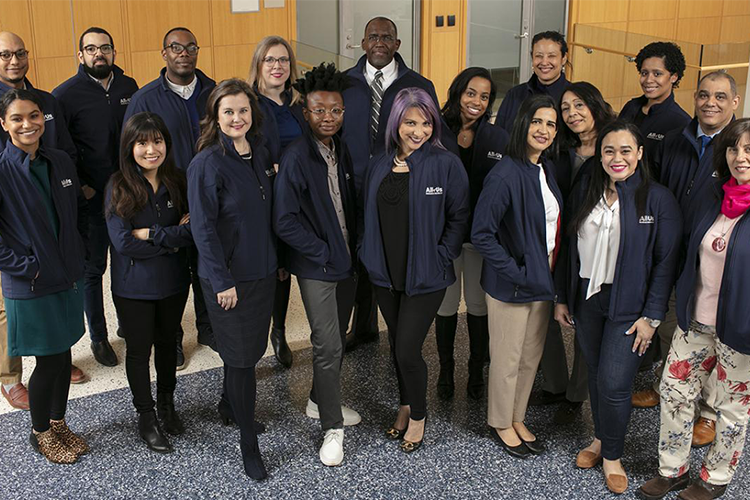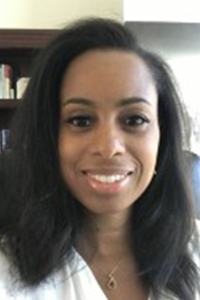The ‘All of Us’ Research Program Is Helping Make Medicine More Precise for Diverse Populations. Five Years In, How Is It Going?
Neighbors learns how Columbia is helping to mobilize community members to help diversify data used to make medicine more precise.

For the last five years, the National Institutes of Health-funded All of Us Research Program has been reaching underrepresented communities from across the country to help create the most diverse health database in history. Collecting long-term information on people's lifestyles, environments, and biological makeup, the hope is that with more diverse data, research will help make medicine and health care more precise, leading to better outcomes for patients of all kinds.
The research is also participatory, meaning those who enroll get access to the information collected, such as highly sought-after genetic testing.
With an overall goal to enroll 1 million people in the program across the country, the New York City Consortium has been hard at work to reach its goal to enroll 93,000 participants from our surrounding community. So far, more than 30,000 people from New York City have joined. The program has five more years to enroll the remaining 63,000 participants.
Columbia University is a part of the consortium, alongside NewYork-Presbyterian - Columbia University Irving Medical Center, Weill-Cornell Medicine, and NYC Health and Hospitals | Harlem.
La Keisha Jones, the engagement manager and retention lead for the New York City Consoritum of All of Us, knows how important more diverse data for research can be—before she was employed by All of Us, Jones herself enrolled in the study in December 2018.
LEARN MORE
"I had my own health concerns as a caregiver and as a patient and navigating that, the All of Us program just resonated so deeply for me," Jones said. "This program is exactly what we need and from what I've seen over the years, especially with the pandemic, is that this program really meets the community where it is."
Jones was joined in conversation by Siobhán Gilbert (CC'09), the communications lead for the program, to discuss how the research program works and what they've learned five years in.
What is the All of Us program?
La Keisha Jones: The All of Us Research Program is coming out of the National Institutes of Health’s Precision Medicine Initiative. The mission is to improve health research to improve health outcomes. We’re trying to move prevention, treatment, and care away from this one-size-fits-all approach to one that is personalized, individualized medicine.

When you sit in front of your doctor, the research, protocols, and the medication that is prescribed are based on research that is more universal. They're looking at how does this fit everyone best versus how does this fit the individual?
Siobhán Gilbert: In addition to the genomic research aspect of this, the All of Us Research Program is collecting data on participants' health, their habits, and what it's like where they live. Someone who lives in Washington Heights is going to have a different lifestyle than someone living in Topeka, Kansas. Right? So, it's making sure all of that additional information provides a greater context.
Collecting this data helps researchers basically understand why people get sick, but also why they stay healthy. And having that in research definitely translates into precision medicine and more precise patient care.
What’s different about this research program?
La Keisha Jones: What's unique about the All of Us Research Program versus any research program that is out there is that the participants are actually partners in this.
Traditionally, people participate in research, we thank them for their contributions, and maybe in 10 years, they'll see something come from the research and maybe they'll benefit from it.
The All of Us Program provides back information quite quickly. From the minute you enroll in the program, you get back your measurements, which include: blood pressure, heart rate, height, weight, BMI, hip circumference, and waist circumference. You’re also getting back genetic results if you want them, which include ancestry and unique genetic traits. This could help you understand predispositions to certain diseases or what medications you might have an adverse reaction to.
As a participant, you can share the testing information with anyone that you choose. You can share it with your healthcare team. You can share that with your family, your loved ones. That's a very powerful thing for a lot of people, to be empowered with that access is a really special dynamic of this program.
The other piece that is different is the data research hub, which has different layers. There’s a public view, which allows you to sort data by age, race, gender, etc. But you can also apply to the NIH as a researcher for further access and sign confidentiality agreements that you won’t try to contact participants or find out who they are. The information is all de-identified and anonymous. So if someone wants to study cancer rates or joint disease in a population at a certain age, they can do that.
We’re hoping with more eyes on the research, whether it be from community colleges or community organizations, not just institutions that have the manpower and the financial capabilities to stand up research programs, that everyone can look at the information and more eyes on the research leads to more discoveries taking place a lot quicker.
What happens when you participate in the program? What is the time commitment?
La Keisha Jones: Even though this program anticipates following an individual for ten years or more, you're not coming to us on a regular basis. So you have the enrollment, which is the online process where you sign the consent forms. Then you review the informational videos to tell you what the program is and what it isn't. You complete the surveys that are on there. You should give yourself about an hour for this process. If you don’t have a computer at home, we have computers at our office that you can make an appointment to come in and use and coordinators will help you with the enrollment process.
And then, when you come in for the physical measurements and the biospecimen collection, which is blood or saliva and urine, then that piece takes about another hour.

After that, you sit back and you wait for your results to come in and you wait for information to come to you. So if there's a new survey that comes out, we’ll let you know, and it's up to the individual, how much, or how little they want to participate. Again, we'd love everyone to continue to complete the surveys as they go along because the more information that we have about lifestyle, environment, family health history, social determinants of health, all of that helps researchers have a more dynamic and full understanding of what is going on. Not only with the individual, but they can see it on a larger scale in communities and different populations.
What's the difference between participating in a research trial and a research program like this?
La Keisha Jones: One thing with a trial is that you are providing treatment. We do not provide treatment. We are just collecting information to create a data cohort of information for researchers to look at and that would be the difference there. The one thing that we do offer, though, is that if something is discovered individuals are notified. If there is something of health significance with the genetic results that is found, then a genetic counselor is offered to them to explain what this means to them and what it can mean to their family.
Our program is giving information back so that people can have more informed conversations. They can be more informed about their risk for a disease possibly, or the risks that they may or may not face. Again, if something comes back, it doesn't necessarily mean that disease could take place, but if they are aware of it, they can keep it to themselves or they could share it with their family, or they could take it to their doctor and just say, "Hey, you know, we would never have known this because genetic testing isn't on the list of things that normally take place and I might be at risk. What should we do about it?" Maybe it means earlier screenings. Maybe it means making healthier decisions.
There are also different levels of participation. Some people just decide they want to do the online portion. Some people want to provide genetic information but not to receive their results. You have the option to say yes, no, maybe, or I don't know yet.
How can someone get involved?
Lakeisha Jones: Anyone over the age of 18 can enroll. It doesn't matter if you have any diseases or don't have any diseases, anything of that sort. We do ask individuals to have an address in the U.S. and contact information here in the U.S. for about six months out of the year, just so that when information is returned, they can make sure that they can be followed up with and be contacted. You don't need health insurance to participate and you do not need to be a U.S. citizen.
That's the beautiful thing about New York, too, we have a very diverse staff. Our staff is bilingual, English and Spanish.
To sign up online or find phone numbers of where to talk to someone about the program, you can visit the New York City Consortium website or call 212-205-9927.